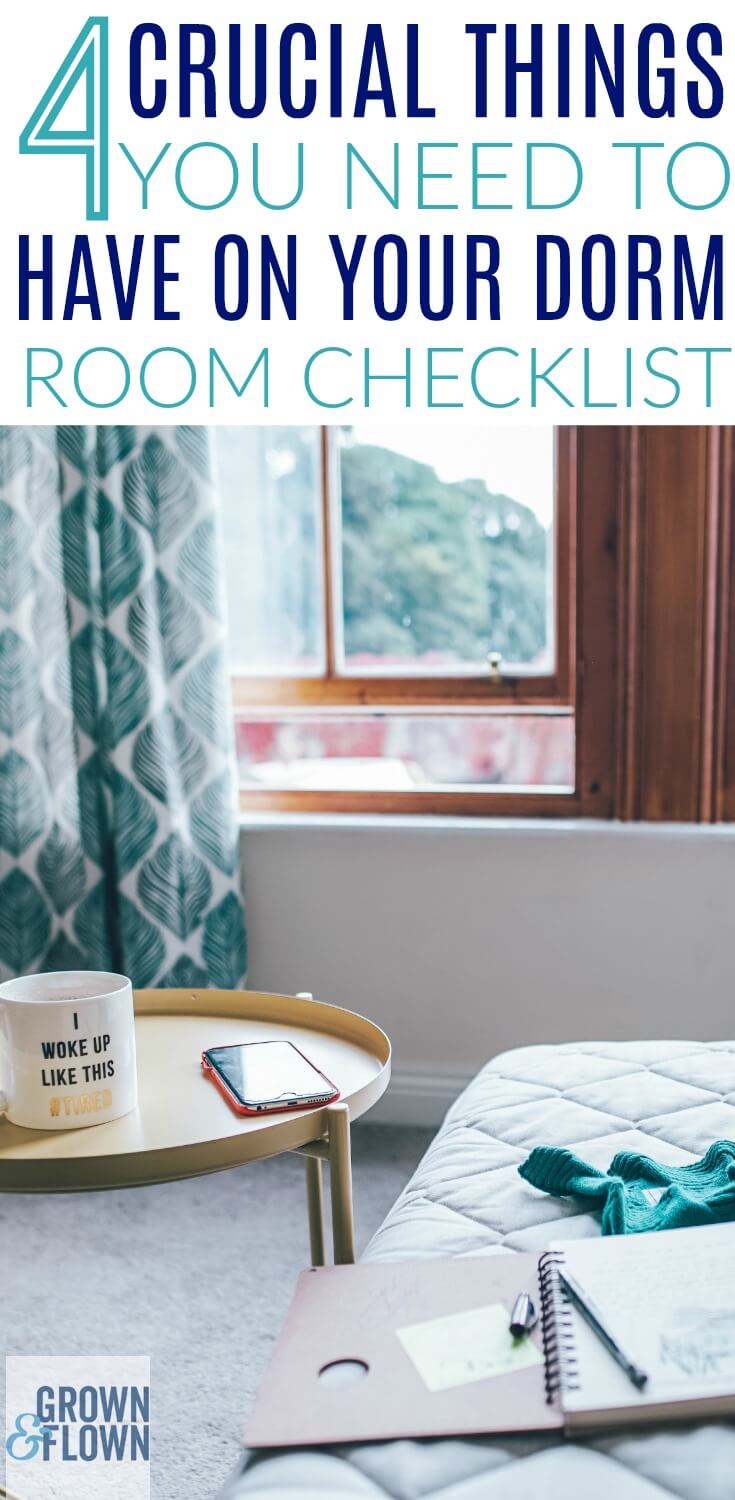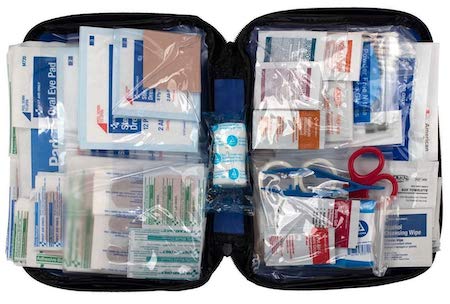College freshmen are finalizing plans for school and, no doubt, their university has provided them with a long list of necessary items – immunization forms, financial information, and registration instructions.
In our household, my wife and teen have downloaded the college dorm checklist and headed off to Bed Bath and Beyond to get the requisite shower caddies and surge protectors. They’ve rented the micro fridge and selected the meal plan.
The items on the list are nearly all checked off. But speaking from experience, here are four items to add to your student’s college dorm list before they venture off for their extended stay away from home.

Four safety items to add to the dorm checklist
1. Health Services Arrangements
The campus probably has a student health center and your student already has information on hours, coverage requirements, records transfer, etc. However, on most campuses, the student health center isn’t open 24 hours a day. Even when open, it can be challenging to get an appointment, especially during cold and flu season. Locate a nearby pharmacy, urgent care facility and local hospital emergency room. Both of you record the locations and phone numbers. Decide how your student will get there for an appointment, or in an emergency.
Look at what transportation services the campus offers and if they have any specific practices or services for emergencies. Decide what you are going to do if there is a medical emergency. Do you go? Are you prepared to go? Do you have a contact locally or at the school that can help you, even if it is just to get information?
One Saturday around midnight, my son called me to say he had been very sick all day and was going down to the main desk in the dorm to see about going to a doctor. That was the last I heard from him for 12 hours. The resident attendant, (per school policy – which I didn’t know at the time) called an ambulance that took him to the hospital. I called his phone for several hours, but the hospital had taken it along with his other personal items.
Around 6 AM, I started calling the local hospitals (there were seven). None of them had any record, or wouldn’t confirm, that he was admitted. My wife was out of town, and I couldn’t reach her. He was hours away. Should I stay and keep making calls from home? Do I drive the three hours to his campus? Whom would I even contact there?
Thankfully, the school had a person on duty that monitors for any student emergencies, and the Assistant Dean of Students called me around 8 AM to see how he was. Where he was, I told her, was the first question. It took her awhile, but she was able to track him through the campus police report, ambulance company, and found the hospital. She got me the hospital name and phone number, room number and some information about his status, and got him his phone. It was fortuitous that the school had such a policy and service. I had no plan.
He turned out to be okay, but there were those hours where he was lost and I was panicked. My take away was that it is beneficial to have a local resource at either the university or a contact in the area that can help you out in an emergency when you aren’t nearby. If there is no contact at the university or you don’t know any locals, turn to your parents association. I’ve joined the parent Facebook group and found that there are plenty of parents locally with students in attendance that are willing to help you and your student with all kinds of support, especially in an emergency.
In addition, unless your student has signed a waiver to Disclose Private Health Care information, it will be difficult to get information in an emergency. Even with a waiver, it can be a problem getting details from a third-party provider. More information on this topic is available here. A local contact may help find out information for you or be present while you cannot.
2. Safety Kit
Cue your teen’s eye roll please. You can’t make your student use it, but you can make them take it, and hopefully remember it should they need it. If there is a lockdown, fire alarm or other need to evacuate your student, will want to have some items to aid them temporarily. Get an inexpensive drawstring backpack to allow for a quick grab and go and fill it with the following items: water bottles, extra phone charger and cable, some power bars, a bandana or face mask, a cheap plastic poncho, flashlight and extra batteries.
A first aid kit is recommended, but not the standard band-aid one. Get an emergency kit, like this one that has 299 essential first aid supplies for treating minor aches and injuries.
The Red Cross also has a good one (RC-562) that is only 9x7x2″ and available from many sellers.
Some experts recommend having some cash in the kit. It is not a bad idea if there is a chance that it would remain there. If your student takes any medication, include a day or two supply.
Finally, if there is room, include some warm clothing – gloves, hat, sweatshirt/pants, and socks. At night or in cold climates they may not have time to dress during an evacuation. Both my college students have stories of the 2 AM fire alarm and standing in the snow in slippers and PJ bottoms waiting for the fire trucks to arrive.
3. Remote Computer Equipment Tracking Software
There is a lot of activity on a college campus and students will be in a comfortable, but open and unfamiliar environment with people they don’t know. They will be moving around all day, and taking their technology with them. It is unfortunate, but more than likely, that at some point your student will either lose or have one of their devices stolen. Both of my boys, at different universities, had equipment stolen in the dining hall when they left it unattended.
Remote tracking software installed on an electronic device gives your student a shot at locating the equipment, and, maybe, provide enough information to the campus police to get it back. Some universities even offer a recovery service where they will track a lost device. Even if you don’t retrieve the device, these products allow the owner to wipe all data remotely to prevent disclosing private information.
The campus may recommend particular products or applications, and offer purchase discounts. If not, there is no shortage of good products and applications available. Android vendors and Apple offer apps with their devices.
There are many other solutions on the market, both free and fee based, depending on your preferences. You will even see products, like Tile stickers, that allow tracking of other valuables or items like keys that a student may misplace. A quick web search will turn up dozens of choices, or consult with your local geek squad team for a recommendation.
Be sure to pick a product that works on all of your student’s devices. If your student has a PC and iPhone, get one system that works with both windows and IOS. Second, select a product that has a web-based console that either you or your student can log into so you can issue the commands if they can’t. Don’t wait until your student is off to school to think about this. These features need to be setup ahead of time and it will be easiest to do while at home, especially if some technical assistance is needed.
4. Renters Insurance
Get renters insurance. Anything that can happen at home can happen at school, and you need to make sure your student has loss coverage. Estimate the cost to replace clothing, books, electronic equipment, furniture, other personal items, and don’t forget that micro fridge. It is likely that your insurance company offers this type of policy, so start with them for a quote.
Some policies will automatically cover electronic and camera equipment and some require a separate rider, so be sure to ask. A renter’s policy will likely include liability coverage for protection in the event of injury to a third-party occurring in your student’s living space.
That’s it. Except for those last-minute items that you need from the local big box store, your college dorm list is now complete.
You Might Also Enjoy Reading:
25 Bestselling Dorm Essentials
When Your Kid is Sick or Has an Emergency, Here are the Forms You Need

Source: https://grownandflown.com/4-crucial-additions-college-dorm-list/
The content is owned by Pete Tropf. Visit site here for other valuable articles.



No comments:
Post a Comment